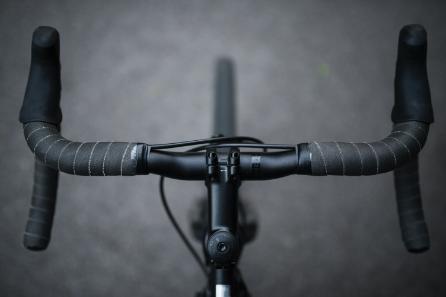This is how to avoid injury if you’ve taken up cycling during the Covid-19 outbreak, according to a Liverpool Hope University expert.
Victoria Joyce is Clinical Tutor in Sportsp Rehabilitation at Hope.
She wants people to use the global pandemic as an opportunity to take to two wheels, whether it’s for daily exercise purposes or to commute to work away from public transport.
But if you’re new to pedalling, or you’re coming back to it, there’s some important posture-related hints you need to know if you’re going to avoid troublesome wrist, knee, back, pelvis and foot pain.
Here Victoria, a former triathlete, reveals her tips for getting on your bike and staying injury free:
Get the seat height right:
“The most important thing in terms of injury prevention on a bike is the set-up. And this starts with getting the saddle height correct - whether it’s an old bike or a brand new one. Find somewhere you’re able to sit on the bike and for it to be free on its own two wheels - perhaps while you’re holding on to a wall or table, or ask someone to assist you. Sit on the saddle and put your heel so it’s at six o’clock to the seat, and your leg locked out, fully straight. You then put your foot where it would naturally be while pedalling the bike - for example, with the ball of your foot. You’ll find you should now have a ‘soft’ knee in this position, with not too much knee bend and which isn’t fully locked out. That’s the optimum riding position in terms of ergonomics. You may have to gradually adjust the seat until it feels comfortable for you.”
Just 2mm millimetres is all it takes to get injured:
“Cyclists need to be aware that the shoes they wear might actually have a bearing on the saddle height. And I’d recommend trying to wear the same equipment all the time. If you’ve got a pair of trainers with quite a thick sole, you might need to adjust your seat height by a couple of millimetres to compensate. And don’t adjust your seat height in bare feet of socks, because again this might have an effect. A couple of millimetres might not sound like a lot but it could actually be the difference between staying fit and picking up an overuse injury.”
Protect the pelvis:
“If the saddle isn’t at the right height for your pelvis, it creates rocking and tilting of the hips, and an increased knee flexion, which can irritate the patellofemoral (PF) area right at the front of the knee. The PF joint may become irritated if the knee is in an increased flexed (bent) position. Rocking of the pelvis can lead to something called ‘greater trochanter bursitis’. The bursas are fluid filled sacs on the side of the pelvis that get irritated and inflamed due to the incorrect position and additional movement of the pelvis. Another issue is pudendal neuralgia, long term pain in the pelvis caused by irritation to the pudendal nerve - the main nerve of the perineum.”

The sensitive ‘undercarriage’:
“There’s no getting away from it. Because of the position you’re in when you’re cycling you can get some perineal irritation, and that goes for men and women. That might manifest as a burning sensation in the groin area. You can also suffer neurological conditions, particularly men, from being in the saddle for too long. You might have pain in what’s known as the ‘ischial tuberosity’, the bony bit of your bottom. For everyday riders, you should be okay if you get the seat position correct, but it’s wise to be aware of the issues. Cycle shorts will help, anti-chafing lubrications can have you feeling more comfortable, and some specific saddles have a hole cut out design to aid with off-loading this sensitive area.”
Best feet forward:
“Under your foot there’s a neurological pathway, the ‘metatarsalgia’. And if you put too much pressure on it, it becomes painful and sore as a point of pressure. This may also cause numbness and tingling in the toes. It might be caused by uncomfortable trainers, foot position, or your seat being at the incorrect height. Another injury may be Plantar Fasciitis, this would manifest as pain under the foot arch. Adjustment of the saddle height and supportive footwear may help to support the foot’s structure during the ‘pushing’ phase of pedalling.”
Handlebar position:
“You don’t need to go out and spend lots of money on a bike. But you do need one which is suitable for what you’re using it for. Don’t go and buy a downhill mountain bike if you’re only commuting to and from work. It’s not going to be ergogenic and efficient. And one of the main factors is getting the hand position set-up correct. For a standard cyclist, the bars should be about level with the seat. This will vary from individual to individual and to what bike you will be riding. Racers might end up with their bars around 5cm lower than their saddle. But if the hand position is too low, you may develop upper limb and back injuries. Increase in compression over the wrist, for example, may lead to injuries which affect the neurological pathways going through the hands and which might manifest as numbness in the fingers.”
Plan your route - and plan rest stops:
“If you’re going out for a ride, you need to know your route. Where are the big hills? Where are you going to stop and take a rest? This preparation helps you to pace yourself and to ultimately avoid overuse injuries. And don’t be afraid to stop for a rest - sometimes we are just tired! And I think a lot of the time people are too hard on themselves. Ride to the weather, too. It’s not just dehydration you need to be careful about, you need to be wary of sunburn and sunstroke. Because of the wind-chill on a bike, you might not feel the effects of the sun until it’s too late. If you’re dehydrated, your musculoskeletal structures are also not going to be functioning as well as they should, leaving you open to injury. Think of the environment and how your body is going to be exposed to it.”
Are your legs spinning too fast…?
“Having too high a cadence means your legs are moving too quickly. It’s just not efficient and can lead to overuse injuries. You should, ideally, be looking to average around 60 revolutions of the crank per minute. That’s a good cadence to keep. If you’ve got the saddle too low, you’re more than likely going to get irritation at the knee, as the knee is bending too much on high repetition.”
Beware sciatica:
“Another common injury among cyclists is sciatica - a pain that runs down the back and into the legs, and also causing pain in the pelvis area. It could be that you’re reaching too far forward, creating a compression of the neural path. Again, re-evaluating your riding position may be warranted and if symptoms do not subside, seek professional advice.”
Don’t overdo it:
“If you’re planning to use your bike to commute to work, don’t overdo it. Instead it’s about loading the body systems gradually. If you’ve not cycled for years, don’t expect to be cycling every day. Set out achievable goals, which you will maintain. If not this is how people become injured and then stop cycling all together. It’s down to the individual as to frequency of exercise recommendations, but in general terms, progression and load needs to be gradual so the body can adapt. Importantly, you need to enjoy it!”
Don’t ignore continual pain:
“It is normal to have Delayed Onset Muscle Soreness (DOMS) as you commence your new activity regime. But there’s a difference between DOMS and an injury. If soreness persists, always seek professional advice or medical attention. A lot of overuse injuries are down to mechanical movements. A specialist can recognise this and the symptoms will resolve. But it’s a lot harder to unpick a chronic injury than it is if you nip it in the bud quickly. The important thing is to be seen, be safe and enjoy being out on your bike and keeping active.”
* Victoria's cycling advice has also been featured in the Daily Mail, which you can read here.
** Victoria also helps to run Liverpool Hope University’s Sports Rehabilitation Clinic, which is open to staff and students as well as members of the public. Consultations and treatment are provided in Hope’s state-of-the-art-facilities within the Health Science and Sport buildings.



